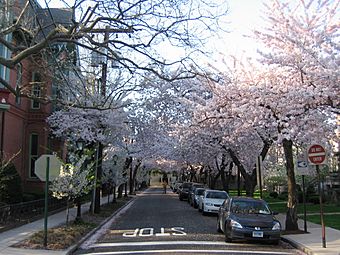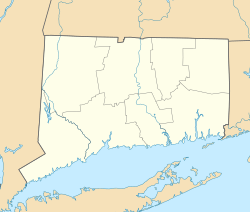Wooster Square Historic District facts for kids
Quick facts for kids |
|
|
Wooster Square Historic District
|
|

Cherry trees in the streets surrounding Wooster Square
|
|
| Location | New Haven, Connecticut |
|---|---|
| Area | 40 acres (16 ha) |
| Architect | Austin, Henry |
| Architectural style | Greek Revival, Second Empire, Italianate |
| NRHP reference No. | 71000914 |
| Added to NRHP | August 5, 1971 |
The Wooster Square Historic District is a special part of the Wooster Square neighborhood in New Haven, Connecticut. It's centered around a rectangular park named after General David Wooster. This area started as a neighborhood in the 1820s. By the 1840s, it was a very popular place to live. Many beautiful homes in the Greek Revival style were built here. In the 1950s, the people living here worked together to save their neighborhood. This effort got attention from all over the country. The district was officially added to the National Register of Historic Places in 1971.
Contents
Exploring Wooster Square's History
Wooster Square is just east of downtown New Haven. A street called State Street and some railroad tracks separate it from the city center. New Haven bought the land for the park in 1825. Before that, it was just open space. The park was named after General David Wooster. He was a hero in the American Revolutionary War. He even owned a building nearby a long time ago.
How the Neighborhood Grew
Wooster Square quickly became a fashionable place to live. Many fancy Greek Revival style houses were built. Some of these homes were designed by a local architect named Henry Austin. Later in the 1800s, New Haven became more industrial. This meant more factories and businesses. Because of this, Wooster Square became less popular for wealthy families. It became a home for many Italian immigrants.
Saving Wooster Square
By the 1930s, some people in the city wanted to tear down the neighborhood. There was even a plan to build a highway, Interstate 91, right through the park! But the people living in Wooster Square didn't want that to happen. They worked together to create plans to save their homes. This happened in the late 1950s. Students who studied architecture from Yale University even helped them. It was amazing that they saved the area. Back then, it was very hard for regular homeowners to get money or help to fix up old buildings.
What You Can See Today
The historic district covers about 40 acres. This includes the park and the streets around it, going out about one block. Some important houses designed by Henry Austin are still there. These include the Howland House at 42 Academy Street and the Willis Bristol House at 584 Chapel Street. Another famous house is the Governor English House at 592 Chapel Street. This house was built for James E. English. He was an important politician who served as a United States Senator and as Governor of Connecticut. The most well-known building that isn't a home is the Conte School. It's on the eastern edge of the district and was built in 1965. This was during the time the neighborhood was being fixed up.
Gallery
-
Max Adler House (1879), 311 Greene St. Adler was owner of Strouse, Adler a block away on Olive St.













